Mrsa causes and symptoms. MRSA Infection: Causes, Symptoms, and Risk Factors Explained
What are the main symptoms of MRSA infection. How does MRSA spread and who is most at risk. What distinguishes MRSA from other staph infections. How can MRSA infections be prevented and treated. Why is MRSA considered a “superbug”.
Understanding MRSA: A Resistant Bacterial Infection
Methicillin-resistant Staphylococcus aureus (MRSA) is a type of bacteria that causes infections resistant to many common antibiotics. This characteristic has earned MRSA the notorious label of a “superbug”. But what exactly makes MRSA different from other bacterial infections?
MRSA is a strain of Staphylococcus aureus (staph) bacteria that has developed resistance to antibiotics like methicillin, oxacillin, penicillin, and amoxicillin. This resistance makes MRSA infections more challenging to treat compared to other staph infections.
Key Facts About MRSA
- Discovered in 1961
- Resistant to many common antibiotics
- Can cause skin infections, pneumonia, and other serious health issues
- Spread through direct contact with infected individuals or contaminated surfaces
- Approximately 2% of the population carries MRSA without being infected
Recognizing MRSA Symptoms: From Skin Infections to Severe Complications
MRSA infections can manifest in various ways, depending on the site of infection. The most common presentation is a skin infection, but MRSA can also cause more severe conditions if it enters the bloodstream or infects internal organs.
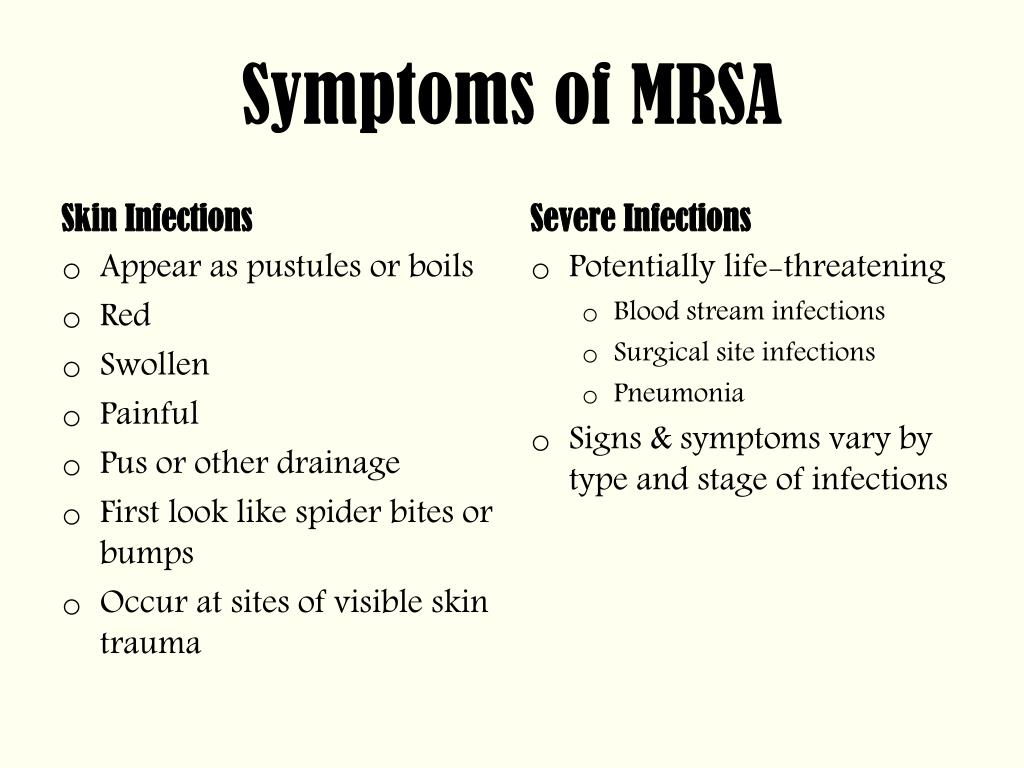
Common Symptoms of MRSA Skin Infections
- Swollen, red, and painful areas on the skin
- Presence of pus or fluid-filled blisters
- Formation of yellow crusting on the affected area
- Resemblance to spider bites (often mistaken as such)
When MRSA infects the lungs and causes pneumonia, patients may experience shortness of breath, fever, and chills. In more severe cases, MRSA can lead to infections in various organs, including the spleen, kidney, spine, heart valves, bones, and joints.
MRSA vs. MSSA: Understanding the Difference
While both MRSA and MSSA (Methicillin-Sensitive Staphylococcus Aureus) are types of staph bacteria, they differ in their antibiotic resistance profiles. How do these two infections compare?
MRSA vs. MSSA Comparison
- MRSA is resistant to many common antibiotics, including methicillin
- MSSA is more susceptible to antibiotics commonly prescribed by doctors
- Both can cause infections if they enter the body
- MRSA infections are generally more challenging to treat due to antibiotic resistance
Despite their differences, both MRSA and MSSA can be carried by healthy individuals without causing infection. In fact, about one-third of the population carries staph bacteria in their noses without experiencing any adverse effects.
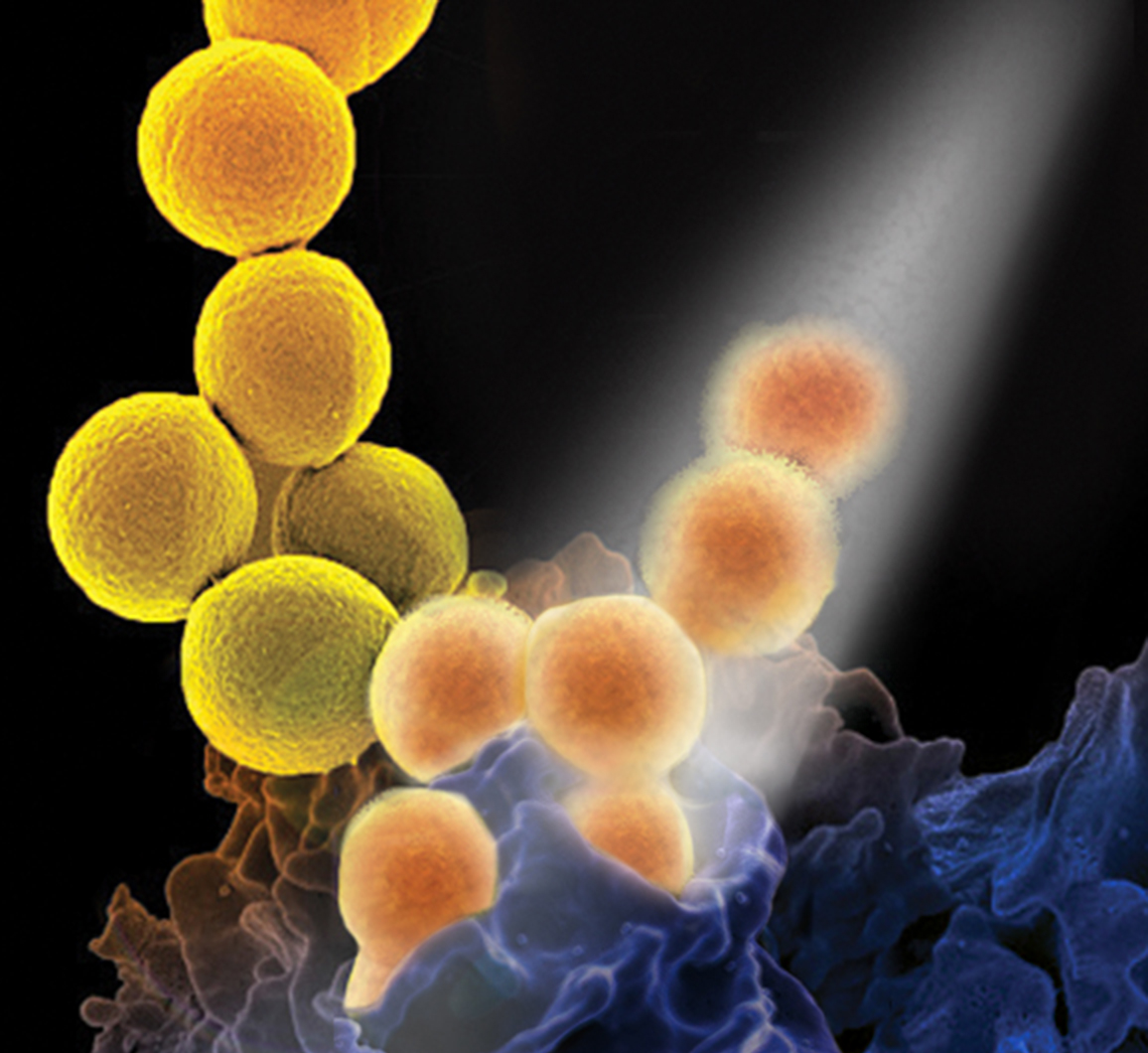
The Spread of MRSA: Understanding Transmission and Risk Factors
MRSA spreads through direct contact with infected individuals or contaminated surfaces. But who is most at risk of contracting MRSA, and how can its spread be prevented?
High-Risk Groups for MRSA Infection
- Hospital patients and healthcare workers
- Residents of long-term care facilities
- Individuals with weakened immune systems
- Athletes in contact sports
- Military personnel
- Prison inmates
- Children in daycare settings
MRSA infections are categorized into two main types: healthcare-associated MRSA (HA-MRSA) and community-associated MRSA (CA-MRSA). HA-MRSA infections typically occur in healthcare settings, while CA-MRSA is found in the general community, particularly among people who share close quarters or have frequent skin-to-skin contact.
The Rise of Community-Associated MRSA (CA-MRSA)
In recent years, there has been a concerning increase in CA-MRSA infections. What factors are contributing to this trend, and how does it differ from healthcare-associated MRSA?
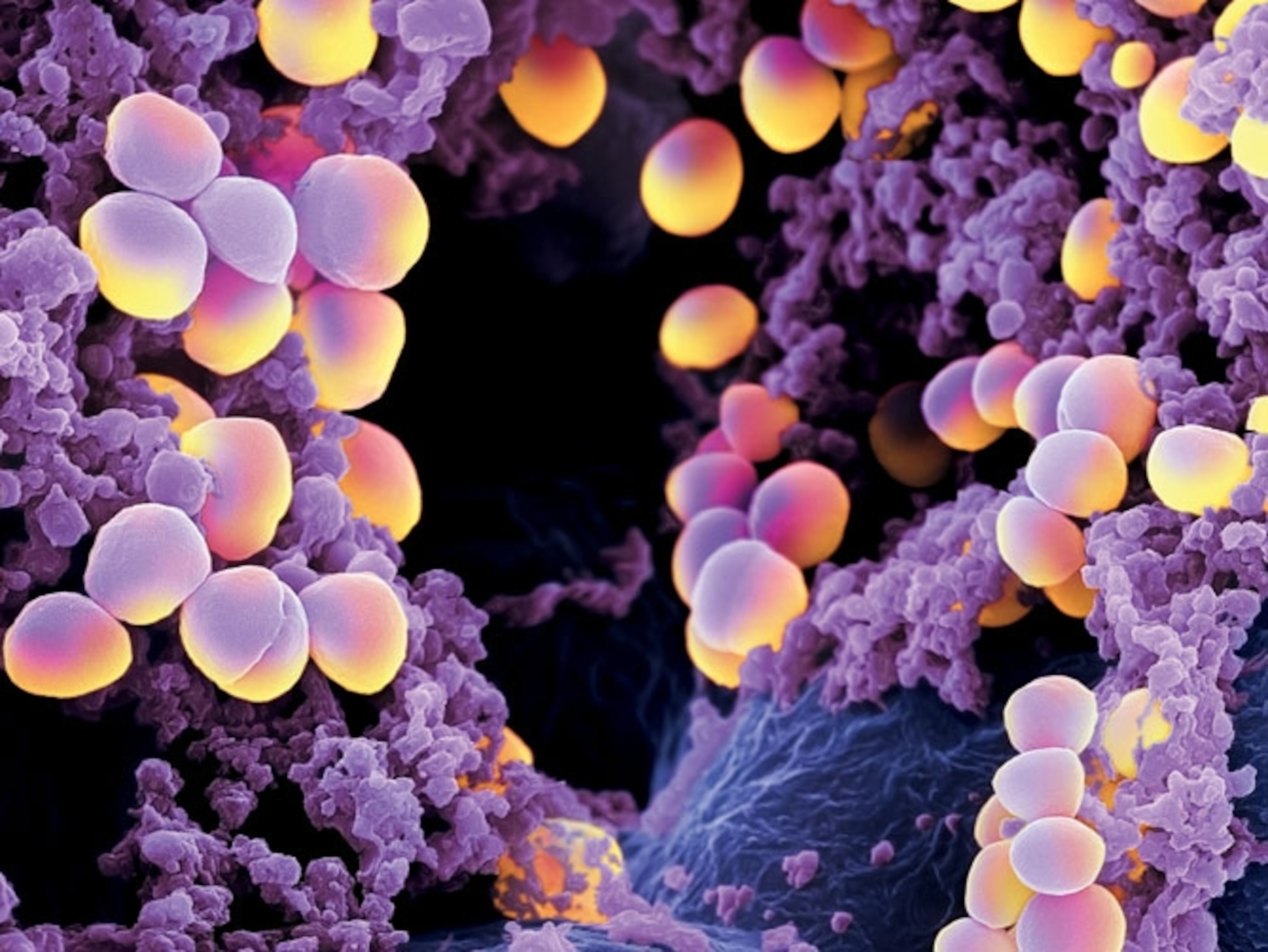
Characteristics of CA-MRSA
- More common in younger populations
- Often affects otherwise healthy individuals
- Frequently causes skin and soft tissue infections
- Can spread rapidly in community settings
The rise of CA-MRSA has led to increased concern among public health experts. Unlike HA-MRSA, which primarily affects individuals in healthcare settings, CA-MRSA can affect anyone in the community, regardless of their health status or previous hospital exposure.
Preventing MRSA: Strategies for Reducing Infection Risk
While MRSA can be challenging to treat, there are several strategies that can help prevent its spread and reduce the risk of infection. What are some effective prevention measures?
MRSA Prevention Tips
- Practice good hand hygiene by washing hands frequently with soap and water
- Keep cuts and scrapes clean and covered until healed
- Avoid sharing personal items like towels, razors, or athletic equipment
- Clean and disinfect frequently touched surfaces regularly
- Follow proper wound care procedures in healthcare settings
- Use antibiotics responsibly and only when necessary
In healthcare settings, implementing existing prevention practices can lead to a significant reduction in certain infections. The Department of Health and Human Services regularly reviews the National Action Plan to Prevent Health Care-Associated Infections to ensure effective strategies are in place.
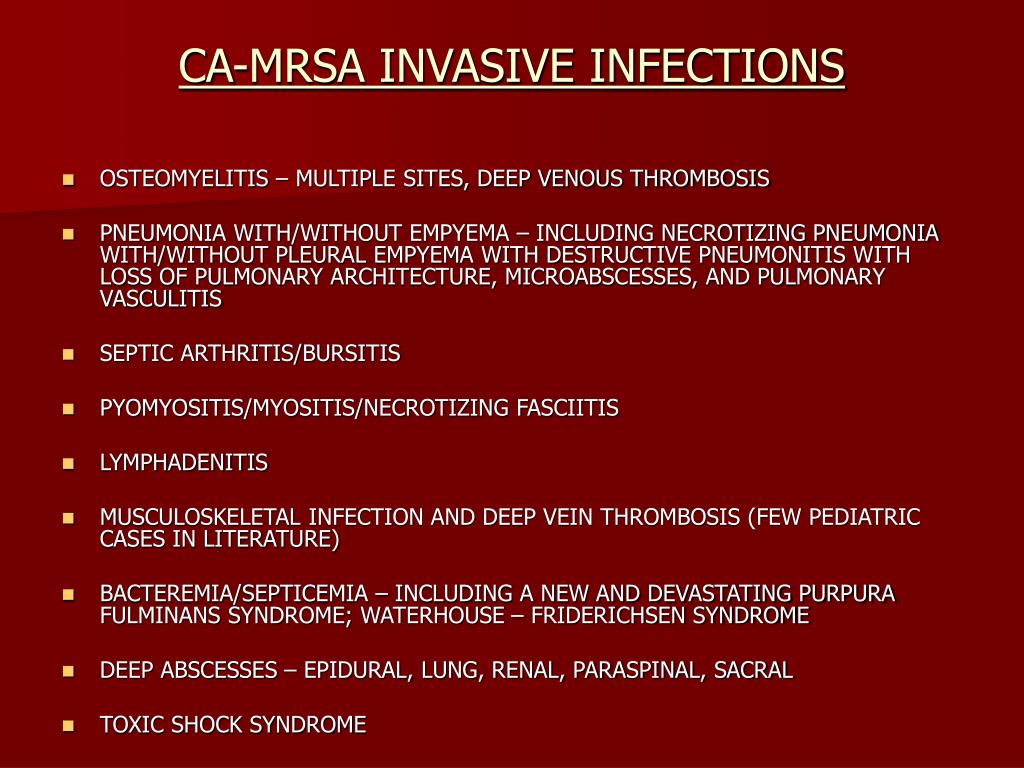
Treatment Options for MRSA Infections
Despite its antibiotic resistance, MRSA infections can be treated with certain medications and procedures. What treatment options are available for MRSA infections?
Common MRSA Treatments
- Specific antibiotics that are still effective against MRSA
- Drainage of skin abscesses or boils
- Intravenous antibiotics for severe infections
- Supportive care for complications like pneumonia
The choice of treatment depends on the severity and location of the infection. While many MRSA skin infections can be treated in a doctor’s office, more serious infections may require hospitalization and intensive care.
The Future of MRSA: Challenges and Research Directions
As MRSA continues to adapt and develop resistance to new antibiotics, researchers face ongoing challenges in developing effective treatments. What are some current areas of focus in MRSA research?
Current MRSA Research Areas
- Development of new antibiotics effective against resistant strains
- Exploration of alternative treatment approaches, such as bacteriophage therapy
- Improving rapid diagnostic techniques for faster identification of MRSA
- Investigating strategies to prevent the development of antibiotic resistance
The ongoing battle against MRSA highlights the importance of responsible antibiotic use and the need for continued research and development in the field of infectious diseases.
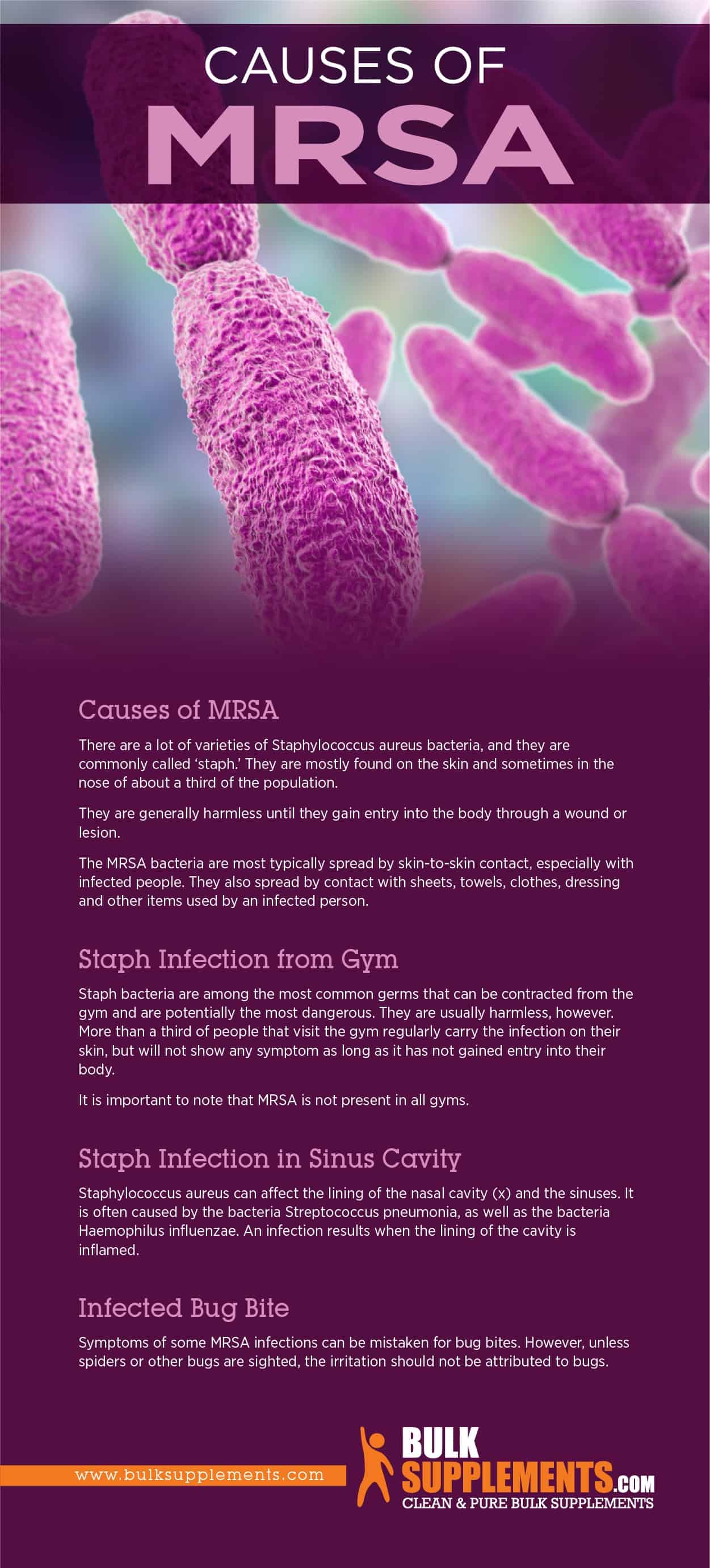
MRSA infections present a significant challenge in both healthcare and community settings. By understanding the causes, symptoms, and risk factors associated with MRSA, individuals and healthcare providers can take proactive steps to prevent its spread and ensure prompt treatment when necessary. As research continues, new strategies for combating this resilient bacteria may emerge, offering hope for more effective prevention and treatment options in the future.
Symptoms, Causes, Treatments, and Your Risk
Written by WebMD Editorial Contributors
- What Is MRSA?
- MRSA Symptoms
- What Causes MRSA?
- MSSA vs. MRSA: What’s the Difference?
- Who Gets MRSA?
- Community-Associated MRSA (CA-MRSA)
- When to Call a Doctor
- More
Methicillin-resistant Staphylococcus aureus (MRSA) is a bacteria that causes infections in different parts of the body. It’s tougher to treat than most strains of staphylococcus aureus – or staph – because it’s resistant to some commonly used antibiotics.
Though most MRSA infections aren’t serious, some can be life-threatening. Many public health experts are alarmed by the spread of tough strains of MRSA. It’s sometimes called a “superbug” because it’s hard to treat.
The symptoms of MRSA infection depend on where you’ve been infected.
MRSA most often appears as a skin infection, like a boil or abscess. It also might infect a surgical wound. In either case, the area would be:
In either case, the area would be:
- Swollen
- Red
- Painful
- Filled with pus
- Have yellow crusting
Many people who have a staph skin infection often mistake it for a spider bite.
If staph infects the lungs and causes pneumonia, you will have:
- Shortness of breath
- Fever
- Chills
MRSA can cause many other symptoms because once it gets into your bloodstream, it can settle anywhere. MRSA can cause an abscess (inflamed tissue with pus inside) in your spleen, kidney, or spine. It can cause endocarditis (heart valve infections), osteomyelitis (bone infections), joint infections, mastitis (infection in the breast), and infections of implanted prosthetic devices (like those used in a knee replacement, for instance). Unlike most MRSA skin infections, which can be treated in the doctor’s office, these more serious infections will land you in the hospital. You’ll get antibiotics in an IV to help kill the infection.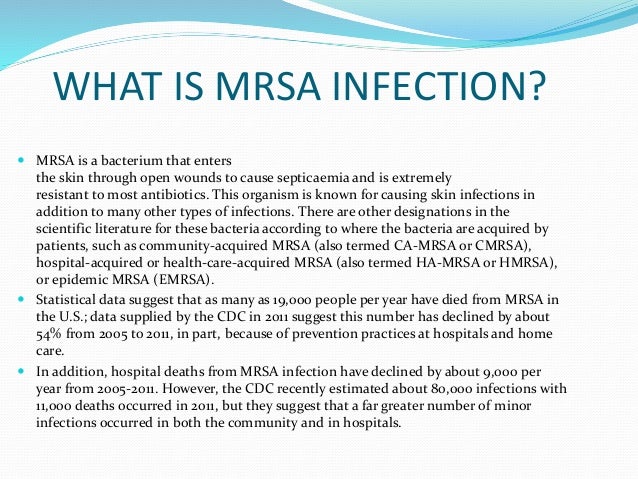
Very rarely, staph can result in necrotizing fasciitis, or “flesh-eating” bacterial infections. These are serious skin infections that spread very quickly. While frightening, very few necrotizing fasciitis cases have been reported.
Garden-variety staph are common bacteria that can live in our bodies. Plenty of healthy people carry staph without being infected by it. In fact, one-third of everybody has staph bacteria in their noses.
But staph can be a problem if it manages to get into the body, often through a cut. Staph is one of the most common causes of skin infections in the U.S. Usually, these are minor and don’t need special treatment. Less often, staph can cause serious problems like infected wounds or pneumonia.
Staph can usually be treated with antibiotics. But over the decades, some strains of staph, like MRSA, have become resistant to antibiotics that once destroyed them. MRSA was discovered in 1961. It’s now resistant to amoxicillin, methicillin, oxacillin, penicillin, and other common antibiotics known as cephalosporins.
While some antibiotics still work, MRSA is constantly adapting. Researchers developing new antibiotics are having a tough time keeping up.
Another type of staph, MSSA (methicillin-sensitive Staphylococcus aureus), is very common. The main difference between MSSA and MRSA is that MSSA is much less resistant to the antibiotics most doctors will give you. It can cause infections, though, if it gets into the body.
MRSA is spread by contact. You could get MRSA by touching another person who has it on their skin. Or you could get it by touching things that have the bacteria on them. MRSA is carried by about 2% of the population (or 2 in 100 people), although most of them aren’t infected.
There are two types of people who get MRSA. One is in decline: those who get it in hospitals or other health care places. The other is on the rise: those who get it in the community.
MRSA infections are common among people who have weak immune systems who are in hospitals, nursing homes, and other health care centers. Infections can appear around surgical wounds or invasive devices, like catheters or implanted feeding tubes.
Infections can appear around surgical wounds or invasive devices, like catheters or implanted feeding tubes.
The Department of Health and Human Services reviews the National Action Plan to Prevent Health Care-Associated Infections regularly. Recent studies suggest that implementing existing prevention practices can lead to up to a 70 percent reduction in certain infections.
Alarmingly, MRSA is also showing up in healthy people who have not been hospitalized. This type of MRSA is called community-associated MRSA, or CA-MRSA.
CA-MRSA skin infections have been identified among some people who share close quarters or have more skin-to-skin contact. Examples are team athletes, military recruits, prison inmates, and children in day care. But more and more CA-MRSA infections are being seen in the general community, especially in certain geographic regions.
CA-MRSA is also more likely to affect younger people. In a study of Minnesotans published in The Journal of the American Medical Association, the average age of people with MRSA in a hospital or health care facility was 68. But the average age of a person with CA-MRSA was only 23.
But the average age of a person with CA-MRSA was only 23.
In most cases, MRSA is easily treated. But MRSA infections can be serious, so make sure you get medical care. You should call your doctor if you notice signs of active infection – most likely of the skin – with a spreading, painful, red rash or abscess.
If you are already being treated for an infection, watch for signs your medicine isn’t working. Those may include:
- The infection is no better after you’ve been taking the antibiotic 3 or 4 days.
- The rash spreads.
- You get a fever, or your fever gets worse.
People who are sick or have weak immune systems have a higher risk of getting serious MRSA infections. If you have a condition that lowers your immunity, call your doctor right away if you think that you might have an infection.
Top Picks
Symptoms, Causes, Treatments, and Your Risk
Written by WebMD Editorial Contributors
- What Is MRSA?
- MRSA Symptoms
- What Causes MRSA?
- MSSA vs.
 MRSA: What’s the Difference?
MRSA: What’s the Difference? - Who Gets MRSA?
- Community-Associated MRSA (CA-MRSA)
- When to Call a Doctor
- More
Methicillin-resistant Staphylococcus aureus (MRSA) is a bacteria that causes infections in different parts of the body. It’s tougher to treat than most strains of staphylococcus aureus – or staph – because it’s resistant to some commonly used antibiotics.
Though most MRSA infections aren’t serious, some can be life-threatening. Many public health experts are alarmed by the spread of tough strains of MRSA. It’s sometimes called a “superbug” because it’s hard to treat.
The symptoms of MRSA infection depend on where you’ve been infected.
MRSA most often appears as a skin infection, like a boil or abscess. It also might infect a surgical wound. In either case, the area would be:
- Swollen
- Red
- Painful
- Filled with pus
- Have yellow crusting
Many people who have a staph skin infection often mistake it for a spider bite.
If staph infects the lungs and causes pneumonia, you will have:
- Shortness of breath
- Fever
- Chills
MRSA can cause many other symptoms because once it gets into your bloodstream, it can settle anywhere. MRSA can cause an abscess (inflamed tissue with pus inside) in your spleen, kidney, or spine. It can cause endocarditis (heart valve infections), osteomyelitis (bone infections), joint infections, mastitis (infection in the breast), and infections of implanted prosthetic devices (like those used in a knee replacement, for instance). Unlike most MRSA skin infections, which can be treated in the doctor’s office, these more serious infections will land you in the hospital. You’ll get antibiotics in an IV to help kill the infection.
Very rarely, staph can result in necrotizing fasciitis, or “flesh-eating” bacterial infections. These are serious skin infections that spread very quickly. While frightening, very few necrotizing fasciitis cases have been reported.
Garden-variety staph are common bacteria that can live in our bodies. Plenty of healthy people carry staph without being infected by it. In fact, one-third of everybody has staph bacteria in their noses.
But staph can be a problem if it manages to get into the body, often through a cut. Staph is one of the most common causes of skin infections in the U.S. Usually, these are minor and don’t need special treatment. Less often, staph can cause serious problems like infected wounds or pneumonia.
Staph can usually be treated with antibiotics. But over the decades, some strains of staph, like MRSA, have become resistant to antibiotics that once destroyed them. MRSA was discovered in 1961. It’s now resistant to amoxicillin, methicillin, oxacillin, penicillin, and other common antibiotics known as cephalosporins.
While some antibiotics still work, MRSA is constantly adapting. Researchers developing new antibiotics are having a tough time keeping up.
Another type of staph, MSSA (methicillin-sensitive Staphylococcus aureus), is very common. The main difference between MSSA and MRSA is that MSSA is much less resistant to the antibiotics most doctors will give you. It can cause infections, though, if it gets into the body.
The main difference between MSSA and MRSA is that MSSA is much less resistant to the antibiotics most doctors will give you. It can cause infections, though, if it gets into the body.
MRSA is spread by contact. You could get MRSA by touching another person who has it on their skin. Or you could get it by touching things that have the bacteria on them. MRSA is carried by about 2% of the population (or 2 in 100 people), although most of them aren’t infected.
There are two types of people who get MRSA. One is in decline: those who get it in hospitals or other health care places. The other is on the rise: those who get it in the community.
MRSA infections are common among people who have weak immune systems who are in hospitals, nursing homes, and other health care centers. Infections can appear around surgical wounds or invasive devices, like catheters or implanted feeding tubes.
The Department of Health and Human Services reviews the National Action Plan to Prevent Health Care-Associated Infections regularly. Recent studies suggest that implementing existing prevention practices can lead to up to a 70 percent reduction in certain infections.
Recent studies suggest that implementing existing prevention practices can lead to up to a 70 percent reduction in certain infections.
Alarmingly, MRSA is also showing up in healthy people who have not been hospitalized. This type of MRSA is called community-associated MRSA, or CA-MRSA.
CA-MRSA skin infections have been identified among some people who share close quarters or have more skin-to-skin contact. Examples are team athletes, military recruits, prison inmates, and children in day care. But more and more CA-MRSA infections are being seen in the general community, especially in certain geographic regions.
CA-MRSA is also more likely to affect younger people. In a study of Minnesotans published in The Journal of the American Medical Association, the average age of people with MRSA in a hospital or health care facility was 68. But the average age of a person with CA-MRSA was only 23.
In most cases, MRSA is easily treated. But MRSA infections can be serious, so make sure you get medical care. You should call your doctor if you notice signs of active infection – most likely of the skin – with a spreading, painful, red rash or abscess.
You should call your doctor if you notice signs of active infection – most likely of the skin – with a spreading, painful, red rash or abscess.
If you are already being treated for an infection, watch for signs your medicine isn’t working. Those may include:
- The infection is no better after you’ve been taking the antibiotic 3 or 4 days.
- The rash spreads.
- You get a fever, or your fever gets worse.
People who are sick or have weak immune systems have a higher risk of getting serious MRSA infections. If you have a condition that lowers your immunity, call your doctor right away if you think that you might have an infection.
Top Picks
Methicillin-resistant Staphylococcus aureus (MRSA) facts
Home
Public Health – Seattle & King County
Communicable diseases and immunization
Fact sheets and data
MRSA
- MRSA facts
What is MRSA?
MRSA is an acronym for Methicillin-resistant Staphylococcus aureus , a bacterium that is resistant to certain antibiotics.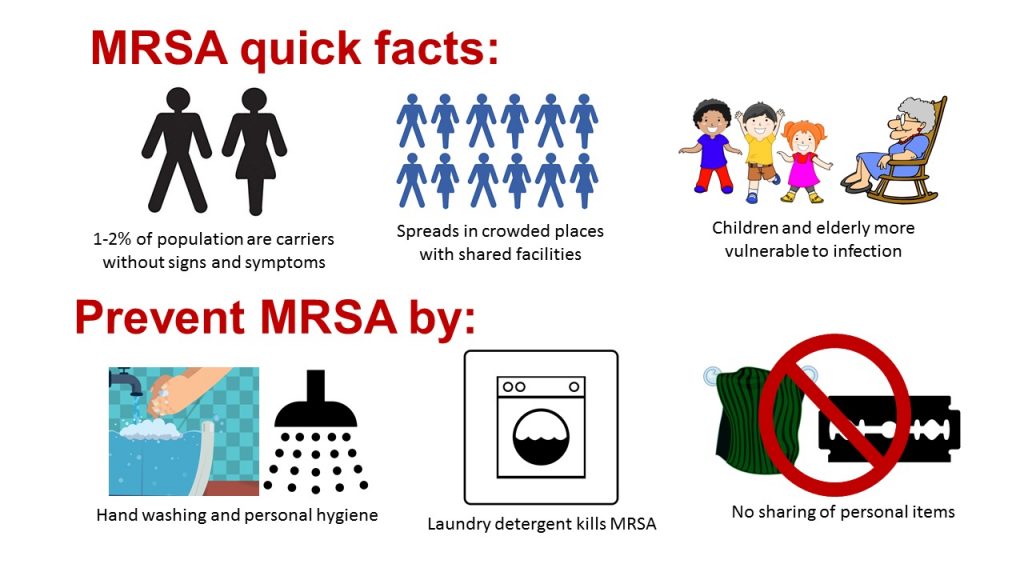 Most MRSA infections cause skin conditions.
Most MRSA infections cause skin conditions.
What are the symptoms of the disease?
Staphylococcal skin infections usually begin as breaks in the skin through which bacteria enter the skin and develop into an infection. The set of symptoms includes:
- Local growth or irritation of the skin with characteristic redness, fever, swelling and pain. The affected area may be filled with pus or fluid.
- In some cases, infected individuals may experience fever or chills.
- Staphylococcal infections are often mistaken for bites from venomous arthropods.
How is the disease spread?
- MRSA infection is spread by close contact with the skin of infected individuals or by sharing objects that have been in direct contact with affected skin. Examples of objects that can be shared to spread staph infections include: towels, soap, dressings, bandages, sheets, clothing, sauna benches or hot tubs, and exercise equipment.

- Fluid or pus coming from the affected area is highly contagious.
- Some people carry MRSA in the nose or throat without experiencing symptoms; at the same time, such persons are included in the high-risk group as the most susceptible to infection.
How is MRSA diagnosed and treated?
- MRSA is usually diagnosed by swab analysis of the infected area. In the case of severe disease caused by MRSA infection, tests will help determine the antibiotic that will be effective in treating the infection.
- Treatment may also involve draining the abscess and cleaning the wound with or without antibiotics.
- Severe illness due to MRSA infection involves the use of antibiotics and, in some cases, hospitalization and surgery.
What are the ways to prevent MRSA?
- Keep cuts and scrapes clean and covered/covered.
- Avoid contact with wounds, bandages and dressings of others.

- Consult your physician immediately if you notice reddening of the wound, an increase in its temperature, or a worsening of its condition after treatment.
- Wash your hands regularly.
- Avoid sharing personal hygiene items such as razors.
- Shower after exercise and exercise.
- Last Updated February 14, 2018
- Share
- Tweet
Wound culture for Staphylococcus aureus (S. aureus) with determination of sensitivity to antimicrobial drugs and bacteriophages , infections. Staphylococci aureus can normally be located on the skin, nasal mucosa, and less often in the larynx, vagina, and intestines. They occur in 30% of healthy people.
If a person has a weak immune system or the normal composition of the microflora is disturbed, then if the skin (mucous membranes) is damaged, Staphylococcus aureus can lead to a variety of local and systemic infectious and inflammatory lesions:
skin (carbuncle, impetigo, folliculitis),
mammary glands (mastitis),
respiratory tract and ENT organs (tonsillitis, sinusitis, otitis, pharyngitis, larinotracheitis, pneumonia),
urinary tract (urethritis, cystitis, pyelonephritis),
digestive system (enteritocolitis, appendicitis, peritonitis, paraproctitis, cholecystitis),
osteoarticular system (osteomyelitis, arthritis).
In some cases, generalization of infection with the development of septicopyemia is possible. Enterotoxin produced by Staphylococcus aureus causes food poisoning and toxic shock syndrome. The main sources of infection: healthy (carriers) and sick people, domestic and farm animals, as well as food containing the infectious agent (most often sugar-containing dairy products). Infection can occur by contact and airborne dust. Possible autoinfection.
To identify Staphylococcus aureus, clinical material is sown on nutrient media, where, in the presence of S. aureus, growth of golden colonies is observed after 18-24 hours.
Determining the number of bacteria may be required, for example, to understand whether treatment is necessary: in some cases, if the number is small, treatment is not carried out. The decision on its necessity depends on the clinical manifestations, as well as on the amount of staphylococcus aureus. With a small content of microbes and the absence of symptoms, treatment may not be needed at all, since these microbes can normally be present on the mucosa. Staphylococcus is constantly found in the intestines, this is not a reason for treatment, but if its amount is exceeded, then measures are needed (the bacterium can cause colic and disorders). Staphylococcus on a smear without symptoms of vaginitis is also normal, while large amounts of staph on a smear, along with an increase in white blood cells, require treatment.
Staphylococcus is constantly found in the intestines, this is not a reason for treatment, but if its amount is exceeded, then measures are needed (the bacterium can cause colic and disorders). Staphylococcus on a smear without symptoms of vaginitis is also normal, while large amounts of staph on a smear, along with an increase in white blood cells, require treatment.
The presence of staphylococcus does not necessarily mean an infection, it can be an asymptomatic carrier, for example, when culture swabs from the nose and throat, the number of bacteria up to 103 is considered a carrier. However, higher numbers tell us about staphylococcus aureus as the cause of the disease, and this is far from asymptomatic carriage.
Much depends on the age of the patient. For example, Staphylococcus aureus in the amount of 104 is a completely normal indicator for children older than 1 year, but in infants in such an amount will already require treatment.
In any case, the presence of staphylococcus in the absence of symptoms of the disease is not a reason to prescribe medication.
The number of staphylococci can be determined before and after treatment. If it turns out that the growth of the pathogen is abundant, then the infection is gaining momentum, the previous therapy was unsuccessful and a new course of treatment is urgently required; moderate and poor growth of microorganisms according to the results of recent analyzes indicates the success of therapy. In addition, in the future it is necessary to control the number of staphylococci within 1 or 2 months after the treatment.
It was also noted that after the stay of patients in the surgical clinic, staphylococcus was found in them twice as often as at admission. In patients admitted to hospitals, there is a replacement of antibiotic-sensitive staphylococci with antibiotic-resistant ones.
Treatment of patients with staphylococcal disease with penicillin or other long-used antibiotics often fails because such drugs often only exacerbate the severity of the infection. Therefore, it is important to establish which antibiotics will be effective in the treatment of staphylococcus aureus.
What is the study used for?
To determine the appropriateness of treatment.
To differentiate between carriers and dangerous infections.
To monitor the patient’s condition after treatment.
To confirm that staphylococcus aureus is the cause of the disease that has occurred (as evidenced by high cultures).
The need to study biological material obtained during surgical interventions is determined by a doctor and is performed in a hospital by qualified personnel. 9
Reference values: no growth.
Staphylococcus aureus in a smear in small quantities is part of the normal human microflora. A significant increase in staphylococcus in a smear can be a symptom of an inflammatory process, skin infections (acne, etc.

 MRSA: What’s the Difference?
MRSA: What’s the Difference?
